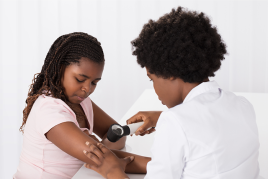Asthma, hay fever, and food allergies: What should I know if my child has eczema?

Follow your child’s eczema treatment plan. The treatment plan developed by your child’s dermatologist can help control eczema, which can stop the eczema from worsening.
Because treatment is so essential, it’s important to tell your child’s dermatologist if:- You have trouble following the treatment plan.
- The treatment plan doesn’t control your child’s eczema.
- Your child develops many skin infections.
Keep your child away from secondhand smoke. No one should smoke around your child. It’s also important that no one smoke inside your home. Breathing in secondhand smoke can increase the risk of developing asthma. In some people, secondhand smoke triggers eczema, causing it to flare.
Learn to recognize signs of food allergy, hay fever, and asthma. If your child develops any of the following signs or symptoms, tell your child’s dermatologist or pediatrician. Treatment can prevent these conditions from worsening.
Asthma: This causes the airways in the lungs to narrow. You may notice your child has:- Difficulty breathing or wheezes
- A breathing problem when breathing in cold air
- Breathing problems when breathing in fragrance or a harsh chemical
- Difficulty breathing due to physical exercise
- Nighttime coughing
Hay fever: This causes inflammation (redness and swelling) inside the nose. It often seems like a child has a cold that just won't go away. You may notice the following:- Stuffy nose
- Sneezing
- Runny nose
- Watery eyes
- Itchy eyes and nose
- Lost sense of smell
- Lost sense of taste
- Cough (from postnasal drip)
Your child may develop the above at certain times of the year. Pollen and mold are common triggers. It's also possible to have hay fever year-round. Animal dander is another common trigger of hay fever.
Food allergy: If your child has a food allergy, your child may develop one or more of the following signs and symptoms:- Hives
- Skin is flushed or red
- Child tries to scratch inside of mouth
- Face, lip, or tongue swells
- Vomiting
- Diarrhea
- Stomach cramps
- Seems dizzy or lightheaded
- Difficulty breathing
These can occur within minutes or hours of eating the food.
Many parents feel helpless when a child has eczema, especially if a child has other health conditions. As you can see, taking action can help your child.
Related AAD resources
References
Eichenfield LF, Tom WL et al. “Guidelines of care for the management of atopic dermatitis. Section 1: Diagnosis and assessment of atopic dermatitis.” J Am Acad Dermatol 2014 Feb; 70(2):338-51.
Sidbury R, Tom WL, et al. “Part 4: Guidelines of Care for the management of atopic dermatitis. Part 4: Prevention of disease flares and use of adjunctive therapies and approaches.” J Am Acad Dermatol 2014 Dec; 71(6):1218-33.
Silverberg J Garg N et al. “New developments in comorbidities of atopic dermatitis.” Cutis 2014 May; 93(5).222-4.
Zheng T, Yu J, et al. “The atopic march: Progression from atopic dermatitis to allergic rhinitis and asthma.” Allergy Asthma Immunol Res. 2011 Apr; 3(2): 67–73.
 Molluscum contagiosum: How to safely treat it
Molluscum contagiosum: How to safely treat it
 Biosimilars: 14 FAQs
Biosimilars: 14 FAQs
 Practice Safe Sun
Practice Safe Sun
 Relieve uncontrollably itchy skin
Relieve uncontrollably itchy skin
 Fade dark spots
Fade dark spots
 Untreatable razor bumps or acne?
Untreatable razor bumps or acne?
 Laser hair removal
Laser hair removal
 Scar treatment
Scar treatment
 Botox
Botox
 Free materials to help raise skin cancer awareness
Free materials to help raise skin cancer awareness
 Dermatologist-approved lesson plans, activities you can use
Dermatologist-approved lesson plans, activities you can use
 Find a Dermatologist
Find a Dermatologist
 What is a dermatologist?
What is a dermatologist?